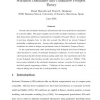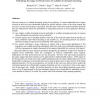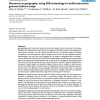493 search results - page 44 / 99 » Representing preferences using intervals |
MANSCI
2006
13 years 7 months ago
2006
Second order stochastic dominance characterizes risk-averse preferences represented by expected utility. This paper supplies second order stochastic dominance conditions that char...
PE
2002
Springer
13 years 7 months ago
2002
Springer
Previous analyses of scalable streaming protocols for delivery of stored multimedia have largely focused on how the server bandwidth required for full-file delivery scales as the ...
IJCAI
1989
13 years 9 months ago
1989
Perturbation analysis deals with the relation ships between small changes in a system's inputs or model and changes in its outputs. Reverse simulation is of particular inte...
CONSTRAINTS
1998
13 years 7 months ago
1998
Abstract. Temporal Constraint Satisfaction is an information technology useful for representing and answering queries about the times of events and the temporal relations between t...
BMCBI
2006
13 years 7 months ago
2006
Background: Many commonly used genome browsers display sequence annotations and related attributes as horizontal data tracks that can be toggled on and off according to user prefe...



